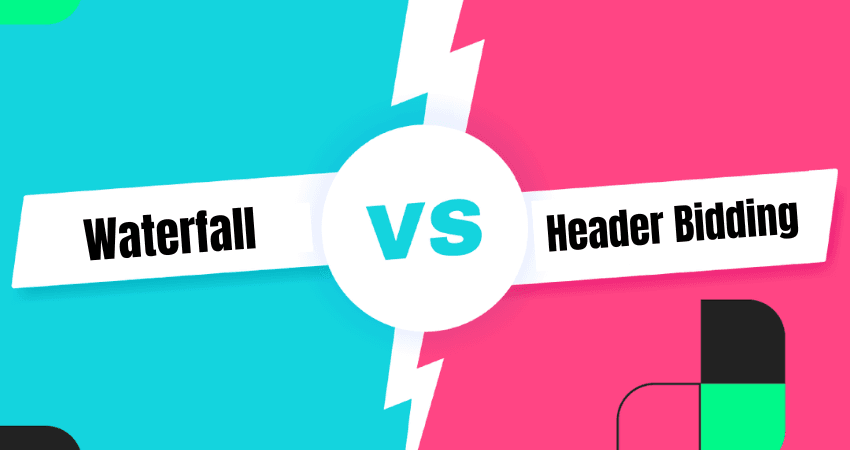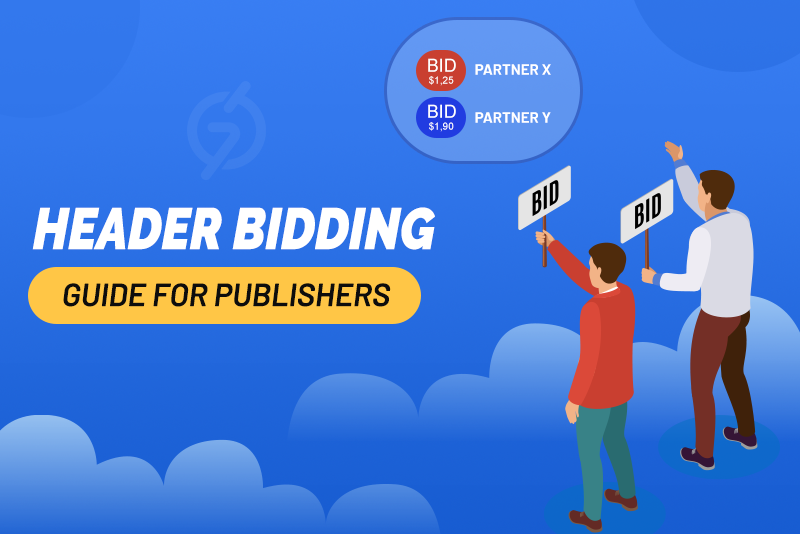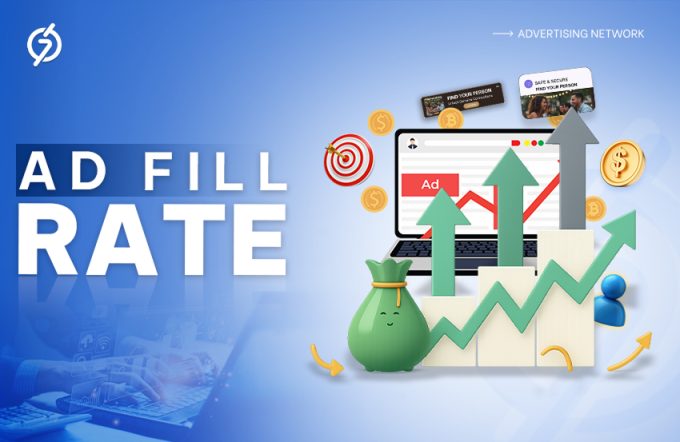Do you know why innovations arise? It’s because necessity enters the scene; that’s why we say necessity is the mother of innovation. It also applies to digital advertising, where the role of bidding is crucial for advertisers as well as publishers’ perspectives. Many publishers often feel they are not maximizing their website ad revenue. They believe more competition could drive up prices. The solution? Header bidding—a method to boost ad earnings.
Suppose you are looking to rent the upper floor of your house. You wouldn’t just take the first offer, right? You look for as many interested tenants as possible to get the best price. Header bidding works the same way for your ad space. It lets multiple advertisers compete at the same time, so you can be sure you’re getting the most money for your valuable space.
Since 2016, header bidding has revolutionized how publishers sell ad space. This technique allows for simultaneous bids from multiple partners, maximizing revenue potential. The success stories are undeniable: The Telegraph saw a 70% increase, and 31% of publishers reported higher yields. With 60% of top websites using header bidding, it’s no passing fad.
This blog will explain everything you need to know about header bidding, from how it works to how it can help you earn more. Let’s take control of your ad revenue together!
Header Bidding: Here is What You Need to Know
Header bidding revolutionizes digital advertising by allowing publishers to auction their ad space simultaneously to multiple ad exchanges, SSPs, DSPs, and ad networks. It is an advanced programmatic advertising technology that boosts publisher revenue by increasing competition for ad space. Unlike the traditional waterfall method, where publishers go to ad networks one by one, header bidding auctions ad inventory to multiple networks concurrently. This creates a real-time marketplace;
- Where all interested parties can compete for the ad space,
- Driving up the price publishers receive for each ad.
It helps publishers earn more from ads by attracting more buyers and being transparent about the process.
The Rise of Header Bidding
Everyone loves the success story, but no one can truly know the exact timeline of how it happened. Most of you are also unaware of the history of header bidding, and to be honest, we were also in the dark until recently. We researched it, and we thought that you should also be aware of its history. Here is a timeline of its development:
Pre-Header Bidding (Before 2014):
- Publishers relied on a method called the ‘Waterfall’ to sell unsold ad inventory after direct deals.
- In the waterfall model, ad networks were ranked based on past performance. {This means that the SSPs or ad networks that perform best in terms of eCPM (earnings per thousand impressions), fill rate (percentage of ad requests filed), and speed will have priority access to bid on ad space.)
- Unsold impressions trickled down the “waterfall” to lower-ranked networks, often at decreasing prices.
- This system lacked transparency and competition for ad space.
Rise of Header Bidding (Around 2014):
- Header bidding emerged as a solution to address the limitations of the waterfall model.
- Introduced around 2014, it revolutionized how publishers sold ad space.
- Instead of a sequential approach, publishers could simultaneously offer ad inventory to multiple ad exchanges.
- This created a competitive bidding environment, allowing publishers to get higher ad space prices.
Rapid Adoption (After 2014):
- Within a year of its introduction, header bidding gained significant traction within the industry.
- Major players in the ad tech space started endorsing the technology.
- Header bidding became an industry standard, replacing the waterfall method for many publishers.
The Inner Workings of Header Bidding
As we understand that, this technique in programmatic advertising helps publishers earn more from their ad inventory. Now, it’s time to understand its inner workings. Here’s how it works:
- Placement- Publishers place a snippet of JavaScript code, called a header bidding wrapper or pre-bidding, in the website’s header section. This code acts like an auctioneer managing the bid process.
- User Visits and Auction begins- When a user visits the webpage, the header bidding wrapper springs into action. It simultaneously sends out requests to multiple demand partners, including ad exchanges, SSPs (Supply-Side Platforms), and DSPs (Demand-Side Platforms). These demand partners represent advertisers competing for ad space on the publisher’s website.
- Bidders Respond- Each demand partner has a limited time window (typically 200-600 milliseconds) to respond with their bid for the ad impression. This timeframe is crucial to avoid slowing down the page loading speed (latency).
- Bids to the Ad Server- Once the time limit is reached, the wrapper collects all the bids received from the demand partners. It then sends these bids to the publisher’s ad server.
- Highest Bid Wins- The ad server acts as the final decision maker. It analyzes the bids from both the header bidding auction and the publisher’s own direct deals (if any). The ad server then awards the ad impression to the highest bidder, maximizing the publisher’s revenue.
- Ad Display- The winning bidder’s ad creative is displayed on the publisher’s website, delivering the ad to the user.
Advantages of Header Bidding for Publishers
It offers various advantages for publishers, including:
Higher Fill Rates
Header bidding opens your inventory to a wider pool of advertisers. This enhances the chances of filling your ad space, including remnant inventory that might otherwise go unsold. By maximizing fill rates, you ensure you are generating revenue from every available impression.
More Control Over Ad Experience
It gives you more control over the types of ads displayed on your site. You can set minimum bid prices (floor prices) to ensure only high-quality ads appear and reject bids that don’t meet your standards. This protects your brand image and user experience.
Improved Transparency and Data Insights
It offers greater transparency into the value of your ad inventory. By receiving bids from various sources, you gain valuable data on how different advertisers value your audience. This lets you optimize your pricing strategy and make data-driven decisions to maximize revenue.
Reduced Reliance on Single Partners
Traditionally, publishers rely on a single ad network or ad exchange. Header bidding diversifies your revenue stream by introducing multiple demand partners or advertising platforms. This reduces dependence on any one partner and ensures you are not leaving money on the table by limiting competition.
Waterfall vs. Header Bidding: A Comparative Analysis
For publishers who want to increase their online advertising revenue, it’s crucial to understand waterfall and header bidding. These two methods have very different ways of selling ad impressions, affecting both earnings and technical complexity.

Waterfall: The Traditional (But Limited) Approach
- Sequential Bidding: Ad networks are contacted one after another in a predetermined order.
- Limited Competition- Only the first available network gets a chance to bid on the ad space.
- Lower Revenue- Potential high bids from later networks are missed.
- Slower Page Load- Waiting for each network response can slow down page loading.
- Easier Setup- Requires minimal technical expertise.
Header Bidding: A Modern and Efficient Method
- Simultaneous Bidding- Multiple ad networks participate in a real-time auction for the ad space.
- Increased Competition- Drives higher bids for your ad inventory.
- Greater Revenue Potential- Maximizes revenue by ensuring the highest bidder wins.
- More Complex Setup- Requires a header bidding wrapper and technical knowledge.
So, What is the Point?
Waterfall might be suitable for beginners with low-traffic websites or those prioritizing a simple setup. On the other hand, header bidding is generally preferred for maximizing revenue, especially for publishers with high traffic or valuable ad inventory.
The Role Of an Adapter in Header Bidding
An adapter in the context of header bidding refers to a crucial component that facilitates the integration of demand from supply-side platforms (SSPs) or monetization platforms into a publisher’s ad stack. Essentially, adapters act as connectors between a header bidding wrapper and SSPs. It enables the flow of bid requests and responses. There are two main types of adapters:
Bidder Adapters
These adapters are designed to fetch demand from SSPs. They handle bid requests, receive bid responses, and facilitate the auction process, ensuring that publishers can access bids from multiple SSPs simultaneously.
Analytics Adapters
Apart from managing bids, analytics adapters focus on tracking and reporting ad performance metrics. They provide insights into ad impressions, clicks, conversions, and other relevant analytics data, helping publishers optimize their ad strategies.
Key Statistics You Can’t Ignore
Here are some important statistics that you might find useful:
- By the end of 2016, header or pre-bidding made up 73% of all digital advertising spending.
- By the end of 2019, 76% of publisher sites utilized header or pre-bidding wrappers.
- 70% of the top 1,000 US publishers, based on Alexa rankings, utilized header or pre-bidding in 2017.
- By the end of 2020, 80% of the top 1,000 US publishers, based on Alexa rankings, were utilizing header or pre-bidding.
- The number of bidders increased by 91% from 2017 to 2020.
- In the first quarter of 2021, 83% of US websites were using header or pre-bidding.
- In the first quarter of 2021, 66% of publishers were using header or pre-bidding wrappers.
Conclusion
Header bidding is a game-changer for publishers looking to maximize their ad revenue. Allowing real-time bidding from multiple ad exchanges increases competition for ad space, driving up prices. While the waterfall method is simpler to set up, it misses out on potential high bids. With its advantages like higher fill rates, more control, and improved data insights, header or pre-bidding is the preferred choice for publishers with high-traffic websites or valuable ad inventory. If you are serious about maximizing your ad revenue, then header or pre-bidding is the best option to consider.
Frequently Asked Questions (FAQs)
What is header or pre-bidding?
Ans. It is a smart way for publishers to sell their ad space to multiple advertisers at the same time, like an auction. This can help publishers earn more money from their website ads.
Why is a header or pre-bidding better than a waterfall?
Ans. The waterfall method was like showing your ad space to one advertiser at a time. With header bidding, it’s like showing your ad space to many advertisers at once so they can all compete to buy it. This competition usually drives up the price.
Are there different types of adapters?
Ans. Yes, there are two main types: bidder adapters and analytics adapters. Bidder adapters help with the auction, while analytics adapters help you track demand partners’ performance.
Does header bidding slow down my website?
Ans. No, the auction process needs to happen very quickly so it does not slow down your website. There are time limits in place to make sure this happens.
Can I set a minimum price for my ad space with header bidding?
Ans. Yes, you can set a minimum price (floor price) to make sure only high-quality ads appear on your site.


















